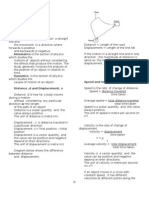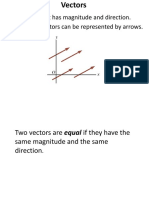Motion
Uploaded by
Hnin NandarMotion
Uploaded by
Hnin NandarMotion _ Practice Questions
Question 1 is based on the following diagram. Write your answers in the blanks.
1. According to the diagram, a physics teacher (T) starts from a point and walks following the
arrowed path and the distance and direction as shown. The entire motion lasts for 24 seconds.
The speed of the teacher is _____________,
0.5ms-1 and the velocity of the teacher is_____________.
0ms-1
2. If a cyclist in the Tour de France travels southwest a total distance of 12,250 m in 1 hour, what
would the velocity of the cyclist be?
A. 3.80 m/s southwest
B. 3.40 m/s southwest
C. 3.40 m/s northwest
D. 3.80 m/s southeast
3. The initial velocity of a body starting from rest is _____________,
A. 1 m/s
B. 2 m/s
C. zero
Questions 4–6 refer to the following information.
Acceleration (a) is the rate of change of velocity (v) of an object; that is,
acceleration = velocity/time or a = v/t
The unit of acceleration is m/s2. Acceleration is a vector quantity because it has both magnitude
and direction. The direction of the acceleration vector depends on two things: whether the object
is speeding up or slowing down, and whether the object is moving in the positive or negative
direction. The general principle for determining acceleration is that if an object is slowing down,
then its acceleration is in the opposite direction of its motion.
The acceleration of gravity (g) is the acceleration for any object moving under the sole influence
of gravitational force. The numerical value for the acceleration of gravity is 9.8 m/s2.
4. A velocity versus time graph for a free-falling object is shown. Which of the following
statements can be inferred from this graph?
A. It shows negative velocity and positive acceleration.
B. It shows negative velocity and negative acceleration.
C. It shows negative velocity and positive momentum.
D. It shows a body at rest.
5. Under which condition is an object accelerating?
A. only when its speed changes
B. only when its direction changes
C. when its speed or direction changes
D. only when its velocity increases
6. A pitcher requires about 0.2 second to throw a baseball. If the ball leaves his hand with a
velocity of 80 m/s, what is its acceleration?
A. 40 m/s2
B. 400 m/s2
C. 40 m/s
D. 4 m/s
7. An eagle flies due east 40 miles per hour for 1 hour and 30 minutes and then 10 miles in the
opposite direction at 20 miles per hour. How far did it fly? _____________miles.
60
8. What is the eagle’s displacement? _____________
50 miles
9. Which of the following represents the eagle’s velocity?
A. 40 mph
B. 40 mph east
C. 25 mph
D. 25 mph east
Directions: Choose the best answer for each of the following items. Questions 10 and 11 are
based on the following graph.
10. Complete the statement with a number.
The object represented in the graph was moving with a speed of______________________
1 miles
per minute.
11. What type of acceleration is demonstrated by the object in the graph?
A. speeding up
B. slowing down
C. no acceleration
D. changing direction
Question 12 refers to the following graph, the paragraph below.
Graphs are often used to convey information about motion. One type of motion graph shows
distance and time. Distance is measured from a particular starting point. If the distance graph has
a straight, horizontal line, the distance is unchanging and the object is not moving. If the distance
graph has a straight line with an upward slope, the distance is changing at a constant rate; this
means that the object is moving at a constant speed. If the distance graph is a curve, the object is
accelerating or decelerating, depending on the shape of the curve.
12. What does the graph above show?
A. an object that is not moving
B. an object that has a constant speed
C. an object that is accelerating
D. an object that is decelerating
-------------------------------------X-----------------------------------X---------------------------------------
You might also like
- AP Physics B Notes - Kinematics in One Dimension100% (1)AP Physics B Notes - Kinematics in One Dimension8 pages
- Phys Int CC CH 2 - Motion in A Straight Line - AnswersNo ratings yetPhys Int CC CH 2 - Motion in A Straight Line - Answers10 pages
- G7 Science Q3-Week 1-2- Speed Velocity and AccelarationNo ratings yetG7 Science Q3-Week 1-2- Speed Velocity and Accelaration66 pages
- Motion Class 9 Science Important QuestionsNo ratings yetMotion Class 9 Science Important Questions9 pages
- NCERT Exemplar Solution Class 9 Chapter 8No ratings yetNCERT Exemplar Solution Class 9 Chapter 811 pages
- NCERT Exemplar Solutions For Class 9 Science Chapter 8 MotionNo ratings yetNCERT Exemplar Solutions For Class 9 Science Chapter 8 Motion12 pages
- Test Bank for College Physics, 8th Editionpdf download100% (2)Test Bank for College Physics, 8th Editionpdf download45 pages
- 2-D Kinematics: Motion in Two Directions General Physics: What Is The Significance of A Negative Quantity?No ratings yet2-D Kinematics: Motion in Two Directions General Physics: What Is The Significance of A Negative Quantity?9 pages
- Uniform Motion Word Problems and Acceleration NotesNo ratings yetUniform Motion Word Problems and Acceleration Notes26 pages
- NCERT Solutions For Class 9 Science Chapter 8 MotionNo ratings yetNCERT Solutions For Class 9 Science Chapter 8 Motion21 pages
- SMK Tat Beng Physics Form 4 2.1 Linear MotionNo ratings yetSMK Tat Beng Physics Form 4 2.1 Linear Motion69 pages
- Applications of Derivatives Rate of Change (Calculus) Mathematics Question BankFrom EverandApplications of Derivatives Rate of Change (Calculus) Mathematics Question BankNo ratings yet
- Topic Sentences: DIRECTIONS: Write A Topic Sentence For Each ParagraphNo ratings yetTopic Sentences: DIRECTIONS: Write A Topic Sentence For Each Paragraph1 page
- Research Article: Dynamic Rocker-Bogie: Kinematical Analysis in A High-Speed Traversal Stability EnhancementNo ratings yetResearch Article: Dynamic Rocker-Bogie: Kinematical Analysis in A High-Speed Traversal Stability Enhancement9 pages
- Chapter 4 Forces and Newton Law's of MotionNo ratings yetChapter 4 Forces and Newton Law's of Motion50 pages
- Seating Plan (Morning) - CAT-A: Sr. No. Course Description Unique Paper No. of StudentNo ratings yetSeating Plan (Morning) - CAT-A: Sr. No. Course Description Unique Paper No. of Student11 pages
- Optical Comm-EC734-OC - Vinay Jha PillaiNo ratings yetOptical Comm-EC734-OC - Vinay Jha Pillai4 pages
- Analysis of Continuos Folded Plate Roofs PDFNo ratings yetAnalysis of Continuos Folded Plate Roofs PDF74 pages
- Topic Test QP (F) g10 (Electricity & Magnetism 2 - 240529 - 180323No ratings yetTopic Test QP (F) g10 (Electricity & Magnetism 2 - 240529 - 1803238 pages
- IB Physics SL Lab Report Specific Heat CapacityNo ratings yetIB Physics SL Lab Report Specific Heat Capacity13 pages
- Sequence Guide - Soda Can Calorimeter Student SampleNo ratings yetSequence Guide - Soda Can Calorimeter Student Sample3 pages
- STRENGTH OF MATERIALS Triangular Load PDFNo ratings yetSTRENGTH OF MATERIALS Triangular Load PDF9 pages
- Treating Harmonics in Electrical Distribution Systems PDF100% (1)Treating Harmonics in Electrical Distribution Systems PDF18 pages
- Chapter 16 Problems-Applied Thermodynamics and Engineering 5th EditionNo ratings yetChapter 16 Problems-Applied Thermodynamics and Engineering 5th Edition5 pages
- John S. Barlow - Inertial Navigation As A Basis For Animal Navigation - 1964 PDFNo ratings yetJohn S. Barlow - Inertial Navigation As A Basis For Animal Navigation - 1964 PDF42 pages
- ENGR 313: Introduction To Materials Science and EngineeringNo ratings yetENGR 313: Introduction To Materials Science and Engineering7 pages
- Phys Int CC CH 2 - Motion in A Straight Line - AnswersPhys Int CC CH 2 - Motion in A Straight Line - Answers
- G7 Science Q3-Week 1-2- Speed Velocity and AccelarationG7 Science Q3-Week 1-2- Speed Velocity and Accelaration
- NCERT Exemplar Solutions For Class 9 Science Chapter 8 MotionNCERT Exemplar Solutions For Class 9 Science Chapter 8 Motion
- Test Bank for College Physics, 8th Editionpdf downloadTest Bank for College Physics, 8th Editionpdf download
- 2-D Kinematics: Motion in Two Directions General Physics: What Is The Significance of A Negative Quantity?2-D Kinematics: Motion in Two Directions General Physics: What Is The Significance of A Negative Quantity?
- Uniform Motion Word Problems and Acceleration NotesUniform Motion Word Problems and Acceleration Notes
- NCERT Solutions For Class 9 Science Chapter 8 MotionNCERT Solutions For Class 9 Science Chapter 8 Motion
- A Complete Course in Physics (Graphs) - First EditionFrom EverandA Complete Course in Physics (Graphs) - First Edition
- Exercises of Kinematics, Dynamics and StaticsFrom EverandExercises of Kinematics, Dynamics and Statics
- Applications of Derivatives Rate of Change (Calculus) Mathematics Question BankFrom EverandApplications of Derivatives Rate of Change (Calculus) Mathematics Question Bank
- A-level Physics Revision: Cheeky Revision ShortcutsFrom EverandA-level Physics Revision: Cheeky Revision Shortcuts
- Topic Sentences: DIRECTIONS: Write A Topic Sentence For Each ParagraphTopic Sentences: DIRECTIONS: Write A Topic Sentence For Each Paragraph
- Research Article: Dynamic Rocker-Bogie: Kinematical Analysis in A High-Speed Traversal Stability EnhancementResearch Article: Dynamic Rocker-Bogie: Kinematical Analysis in A High-Speed Traversal Stability Enhancement
- Seating Plan (Morning) - CAT-A: Sr. No. Course Description Unique Paper No. of StudentSeating Plan (Morning) - CAT-A: Sr. No. Course Description Unique Paper No. of Student
- Topic Test QP (F) g10 (Electricity & Magnetism 2 - 240529 - 180323Topic Test QP (F) g10 (Electricity & Magnetism 2 - 240529 - 180323
- Sequence Guide - Soda Can Calorimeter Student SampleSequence Guide - Soda Can Calorimeter Student Sample
- Treating Harmonics in Electrical Distribution Systems PDFTreating Harmonics in Electrical Distribution Systems PDF
- Chapter 16 Problems-Applied Thermodynamics and Engineering 5th EditionChapter 16 Problems-Applied Thermodynamics and Engineering 5th Edition
- John S. Barlow - Inertial Navigation As A Basis For Animal Navigation - 1964 PDFJohn S. Barlow - Inertial Navigation As A Basis For Animal Navigation - 1964 PDF
- ENGR 313: Introduction To Materials Science and EngineeringENGR 313: Introduction To Materials Science and Engineering





























































































